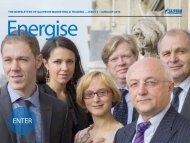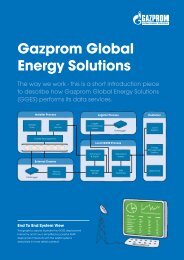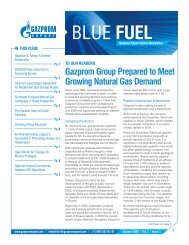Natural Gas as the Fuel of Choice From the EuropeanGas Forum PerspectiveContinued from page 19balanced European energy mix, alongsideother energy sources, and to highlight theissues of cost and moral hazard in ongoingdebates.As industrialized economies, we alsoneeded to position gas more effectively asan intrinsic part of a longerterm alternative.As a first step, EGaF fielded a study titled“Making the Green Journey Work” thatcovers all sectors of the European economy.The main focus is on power generatorsbut other sectors are also included, albeitcovered in less detail. The study providesa technical analysis of the contributionthat natural gas can make to meeting CO 2emission reductions as targeted by the EU. Itbuilds on scenarios outlined in the EuropeanClimate Foundation (ECF) Roadmap2050 and describes three potential waysto achieve the 80% emissions abatementtargets by 2050.The first conclusion of the study was thatEurope should refrain from mandatingspecific technologies as part of settingCO 2emission targets for the period until2050. The benefits of this strategy wereoutlined to lead to significant cost savings,maintaining European competitiveness,and hence put no restraint on economicgrowth. Two reasons fermented theaforementioned conclusion. First, there isconsiderable predictive uncertainty whichnew technologies will be readily available30-40 years from now, and at what cost.Second, flexibility is needed to deliver alow carbon energy mix which will be costefficient during the period in question.The other conclusion of the study wasthat Europe should rely on existing maturetechnologies at first and gradually move intonew technologies (such as carbon capture& storage and others) at a later stage, oncethe feasibility and their performances werebetter established. This would allow newtechnologies to come to maturity and havea lower impact on costs.Compared to the reference scenario (i.e.,60% RES scenario of the ECF Roadmap2050), the alternatives proposed by EGaFachieve significant cost savings to meetCO 2reduction targets, by using naturalgas in a more balanced energy mix, thatrelies less on coal and less on higher costrenewable technologies. For the period2010-2030, total costs savings in the powersector could be in the vicinity of €250-500 bn. This is about half the investmentneeded in this sector by 2030. Additionalsavings of a similar magnitude are alsopossible for the period between 2030and 2050, although costs are much moreuncertain given the uncertainties in terms ofinvestment costs in that time frame.Natural gas enjoys the lowest cost ofcapital compared to other power generationschemes that are capable of meetingemissions goals. Combined-cycle gas plantsemit half as much CO 2per kilowatt-hour asmodern supercritical coal plants and theyare two-to-three times less capital intensive.While operating costs are low, renewablescan be very expensive both in start-upcapital costs and transmission grid impactcosts. Nevertheless, we do see a significantrole for lower cost renewables as part of acost-efficient future energy generation mix.The study demonstrates that EU emissiongoals could be met by utilizing slightly less ofthe more expensive renewables, comparedto the higher renewable utilization scenario,particularly with respect to the next 20 years.If adopted natural gas-fired generationwill normally be the lowest cost source ofback-up thermal generation required tocomplement intermittent renewables (suchas wind power) and help maintain energysupply security.Hence, adopting alternatives as outlinedby the study between 2010-2030 would20
<strong>October</strong> 2012 | Vol. 5 | Issue 3BLUE FUELprovide Europe with more time to select and fine-tune itscarbon abatement plans by 2050. Policy support should bereasonably even-handed across a range of low carbon energytechnologies (which include but are not limited to renewables)for providing additional “start-up” support for emergingtechnologies which promise a competitive cost of CO 2abatement in due course.EGaF is exploring the residential and the transportation sectorsin more detail with two additional studies. The residentialstudy was made public on 19 July, while publication of thetransportation study will soon follow. Both studies highlight thepotential cost savings to meet the 2050 CO 2emissions targetsthrough a higher reliance on natural gas technologies.In the residential sector adopting a more diverse technologymix that include gas fuelled heat pumps, gas-fired DistrictHeating and Combined Heat and Power (CHP) could lead tocost savings in the order of €100-120bn compared to a higherelectrification pathway by 2030. In the transportation sector, anincreased reliance on natural gas powered vehicles (particularlyan increased use of LNG as a bunkering and heavy truckingfuel) could also lead to significant savings (in the order of€60-70bn, to 2030) while remaining on track to meet the EUTransport White Paper’s 2050 GHG reduction targets.These two complementary approaches show how a lowercost,lower-risk, and low-carbon energy mix for Europe can beachieved based on cost-effective and technology neutral CO 2mitigation solutions, combining necessary actions on climatechange with secure and affordable access to energy.EGaF has met on several occasions with EU CommissionerOettinger and representatives of DG Energy to presentits results. It also met with other stakeholders of other gasorganizations such as Eurogas, IGU, Gas Naturally, or NGO’ssuch as ECF, Greenpeace, WWF. It has received very positivefeedbacks and gained some significant momentum in thedebate over the future of the energy mix in Europe.In terms of perspectives for natural gas in Europe, it is fair tosay that things have changed significantly over the last twoyears. The impact of Fukushima and the economic downturnhave shed a new light on the energy future of Europe. Leavingoptions open, relying on a balanced energy mix and ensuringthat we avoid unnecessary costs to the economy are now beingaddressed more prominently.Natural gas now has a much brighter future perspective,although a lot remains to be done, particularly with respectto ensuring that natural gas remains a competitive energysource. In the light of abundant due to the unconventionalgas revolution, increased diversity of supply and efficienttechnological solutions, we are confident in the tremendousopportunities of growth that natural gas offers in the short andlong term.At EGaF, we like to think that part of this effort is due to theextensive work done by our members. Yet, challenges remainand EGaF intends to continue to be part of the debate.To learn more, please visit http://europeangasforum.eu/Energy and LeadershipBy Eric Dam, president of the Energy Delta InstituteEnergy plays a crucial role in supporting our modern wayof life. In spite of significant progress in the efficiency of itsuse, energy consumption will continue to rise as incomelevels grow and increased access to energy is guaranteedto an ever growing population. In order to meet growingglobal energy demand, the energy sector has to work hardto overcome numerous challenges. Exploring the unknownarea’s for new gas, energy transition, CO 2reduction,market liberalization, and the need for new and differentinfrastructure services are but a few of the challenges thatlay ahead. It will be up to future executives and leaders ofthe energy industry to meet and resolve these issues. Thiswill require skills, knowledge and expertise in an ever morecomplex industry.To identify what skills and competences are needed tobecome a successful executive in the energy industry,the Energy Delta Institute (EDI) conducted a market surveyContinues on page 22www.gazpromexport.com | newsletter@gazpromexport.com | +7 (499) 503-61-61 | comm@gazpromexport.com 21ÝÊÑÏÎÐÒ
















